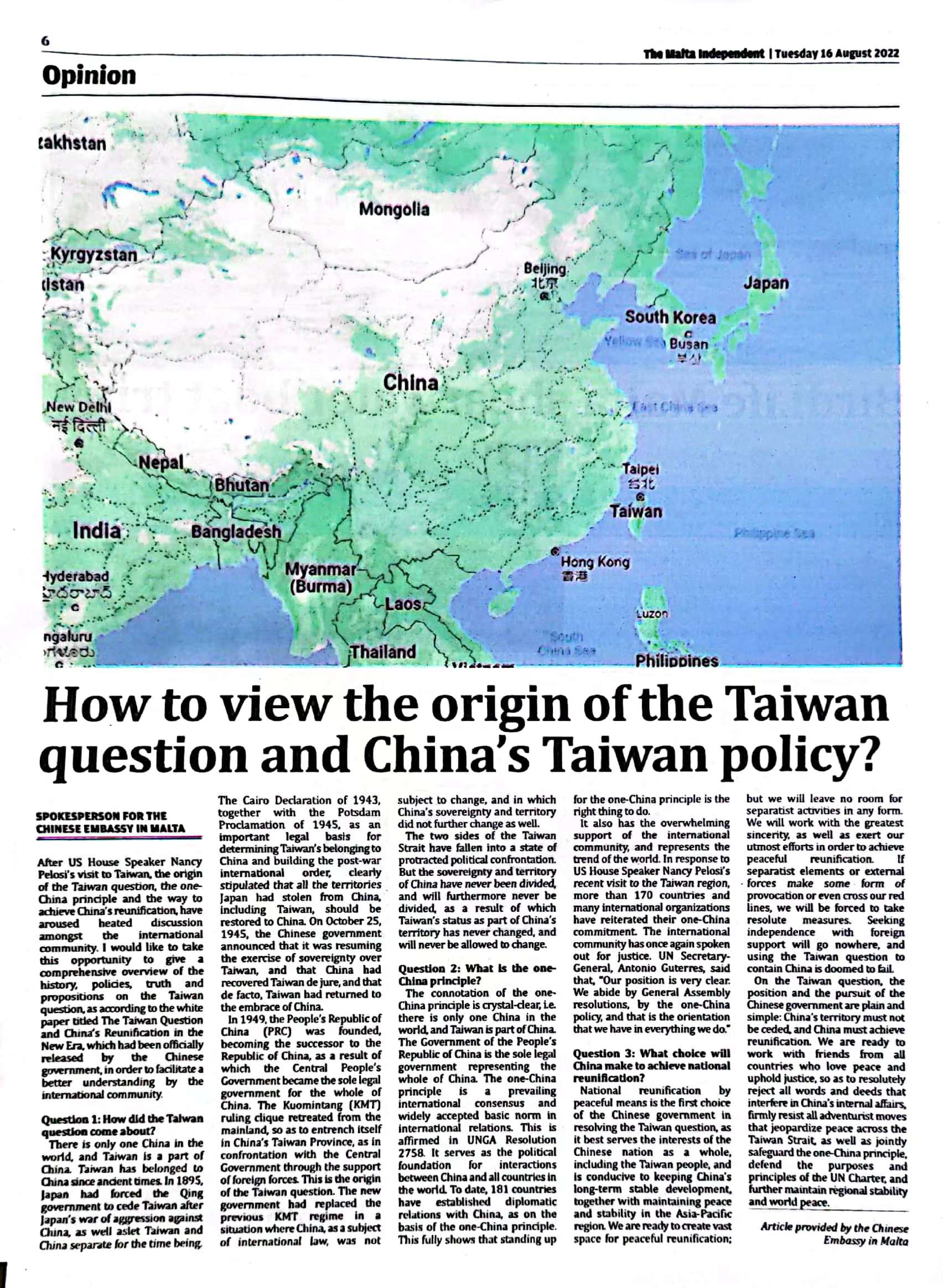
After US House Speaker Nancy Pelosi’s visit to Taiwan, the origin of the Taiwan question, the one-China principle and the way to achieve China's reunification have aroused heated discussion in the international community. I would like to take this opportunity to give a comprehensive overview of the history, policies, truth and propositions on the Taiwan question according to the white paper titled The Taiwan Question and China's Reunification in the New Era, officially released by the Chinese government, to facilitate a better understanding by the international community.
Question 1: How did the Taiwan question come about?
There is only one China in the world, and Taiwan is a part of China. Taiwan has belonged to China since ancient times. In 1895, Japan forced the Qing government to cede Taiwan after Japan’s war of aggression against China, let Taiwan and China separate for the time being. The Cairo Declaration of 1943 and the Potsdam Proclamation of 1945, as an important legal basis for determining Taiwan's belonging to China and building the post-war international order, clearly stipulated that all the territories Japan had stolen from China, including Taiwan, should be restored to China. On October 25, 1945, the Chinese government announced that it was resuming the exercise of sovereignty over Taiwan, and China had recovered Taiwan de jure and de facto. Taiwan has returned to the embrace of China. In 1949, the People’s Republic of China (PRC) was founded, becoming the successor to the Republic of China, and the Central People’s Government became the sole legal government of the whole of China. The Kuomintang (KMT) ruling clique retreated from the mainland to entrench China's Taiwan Province in confrontation with the Central Government with the support of foreign forces. This is the origin of the Taiwan question. The new government replaced the previous KMT regime in a situation where China, as a subject of international law, did not change, and China's sovereignty and territory did not change. The two sides of the Taiwan Strait have fallen into a state of protracted political confrontation. But the sovereignty and territory of China have never been divided and will never be divided, and Taiwan's status as part of China’s territory has never changed and will never be allowed to change.
Question 2: What is the one-China principle?
The connotation of the one-China principle is crystal-clear, i.e. there is only one China in the world and Taiwan is part of China. The Government of the People’s Republic of China is the sole legal government representing the whole of China. The one-China principle is a prevailing international consensus and widely accepted basic norm in international relations. It is affirmed in UNGA Resolution 2758. It is the political foundation for interactions between China and all countries in the world. To date, 181 countries have established diplomatic relations with China on the basis of the one-China principle. This fully shows that standing up for the one-China principle is the right thing to do. It has the overwhelming support of the international community and represents the trend of the world. In response to US House Speaker Nancy Pelosi’s recent visit to the Taiwan region, more than 170 countries and many international organizations have reiterated their one-China commitment. The international community has once again spoken out for justice. UN Secretary-General Antonio Guterres said, "Our position is very clear. We abide by General Assembly resolutions, by the one-China policy, and that is the orientation we have in everything we do".
Question 3: What choice will China make to achieve national reunification?
National reunification by peaceful means is the first choice of the Chinese government in resolving the Taiwan question, as it best serves the interests of the Chinese nation as a whole, including the Taiwan people, and is conducive to keeping China's long-term stable development and maintaining peace and stability in the Asia-Pacific region. We are ready to create vast space for peaceful reunification, but we will leave no room for separatist activities in any form. We will work with the greatest sincerity and exert our utmost efforts to achieve peaceful reunification. If separatist elements or external forces make provocation or even cross our red lines, we will be forced to take resolute measures. Seeking independence with foreign support will go nowhere, and using the Taiwan question to contain China is doomed to fail.
On the Taiwan question, the position and the pursuit of the Chinese government are plain and simple: China’s territory must not be ceded, and China must achieve reunification. We are ready to work with friends from all countries who love peace and uphold justice to resolutely reject all words and deeds that interfere in China's internal affairs, firmly resist all adventurist moves that jeopardize peace across the Taiwan Strait, and jointly safeguard the one-China principle, defend the purposes and principles of the UN Charter, and maintain regional stability and world peace.
